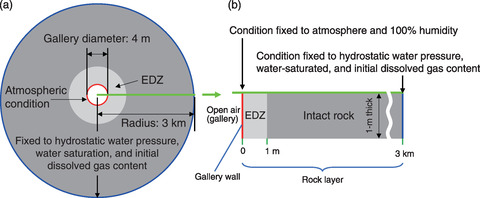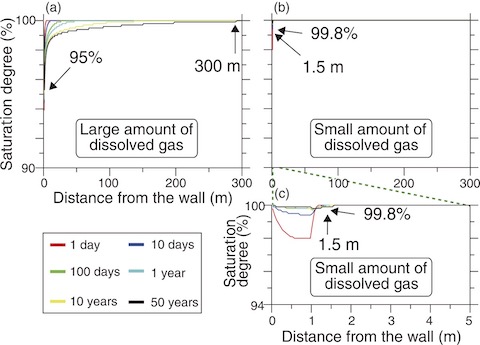
Fig.8-20 Conceptual model and boundary conditions

Fig.8-21 Results for cases mimicking the 250 m gallery
Table 8-3 Parameters used in base case

Excavating underground facilities to dispose of high-level radioactive waste (HLW) geologically is expected to cause the rock around galleries to desaturate, especially near the newly created fractures of the EDZ. Desaturation affects rock's hydraulic properties, increasing gas mobility relative to groundwater, leading to air infusion into rocks, and increasing the solubility and mobility of radionuclides. However, a significant amount of dissolved gas has been shown to emanate from the gallery walls, suggesting that this dissolved gas inhibits air entry into the surrounding rock and plays an important role in the desaturation process. Therefore, we aimed to clarify the factors contributing to rock desaturation. Thus, the effects of dissolved gas and rock permeability on desaturation were investigated using numerical simulation.
A sensitivity analysis of gas content and rock permeability was performed using a numerical simulator for the two-phase flow of the groundwater and gas in the model mimicking the gallery of the Horonobe URL; this model is summarized in Fig.8-20. As an initial condition, the rock was assumed to be saturated with groundwater that was saturated with dissolved CH4 and CO2 gases at hydrostatic pressure. The two-phase flow of groundwater and gas, which is caused by a large pressure gradient between atmospheric pressure at the gallery and hydrostatic pressure, was calculated for 50 years. The parameters used for the base case demonstrating the conditions in the 250 m gallery are shown in Table 8-3 as an example. To assess the effects of the dissolved gas content and the rock permeability on desaturation, several cases were calculated assuming various amounts of dissolved gas and permeability.
The results of the base case and a case assuming a low amount of dissolved gas are shown in Figs.8-21(a) and 8-21(b), respectively. In the base case, there was a minimal degree of saturation near the EDZ, and the spatial extent (i.e., distance from the wall) of desaturation reached approximately 300 m after 50 years. Decreasing the amount of dissolved gas caused almost no decrease in saturation degree within 50 years and reduced the spatial extent of desaturation near the EDZ. When the permeability of intact rock was increased, the degree of saturation was similar to that of the base case, but the extent of desaturation increased.
Overall, we determined that the initial dissolved gas content affects both the degree and spatial extent of rock desaturation. Further, rock permeability can affect the spatial extent of desaturation but has little effect on the degree of saturation. These results will advance investigation efforts into the mechanism of O2 infusion into rock and R&D efforts to secure and ensure the retrievability of HLW, thereby ensuring the long-term safety of the underground facility.
(Kazuya Miyakawa)